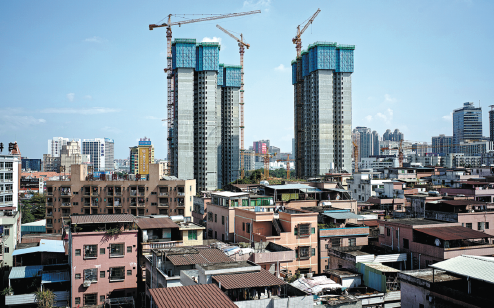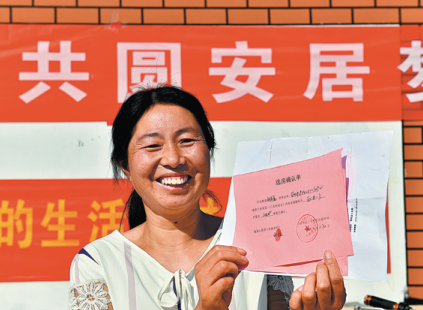CHINESE HOME DREAMS COME TRUE
Reform has seen country develop world's largest private sector real estate market
Editor's note: To celebrate the 100th anniversary of the founding of the Communist Party of China, China Daily is publishing a series of stories on the changes and developments in various fields and industries.
Since ancient times, Chinese scholars and officials have pictured an ideal world in which every family has a home of their own.
That dream is coming true as the country prepares to celebrate the centenary of the founding of the Communist Party of China. The quality of newly built housing has improved continuously and housing conditions in established homes have also been upgraded.
Li Shuqi, 43, is a typical beneficiary of those changes. Li and her parents used to live in a 16-square-meter room in a narrow alley in Shanghai, with a shared kitchen outside. Li called the room multifunctional-it was the bedroom at night, a living room during the day, and a shower and bathroom whenever it needed to be.
But the living conditions were still much better than in the small home they shared with her aunt in a shantytown in Shanghai's Changning district before she was 5. The walls there were so thin they could hear the neighbors if they spoke even a little loudly.
Li's life improved significantly in 1988, when the family moved into a much bigger two-bedroom apartment, meaning she could finally have her own bedroom. She also no longer had to clean the wooden toilet anymore, as their new home had a flush toilet.
Her story is an example of China's achievements in improving people's living conditions. The per capita urban housing floor area last year was 40.5 square meters, up from 8.3 sq m in 1949, said Shaun Brodie, senior director and head of occupier research for China with Cushman & Wakefield, citing data from the National Bureau of Statistics.
In addition to improved housing conditions, China saw more than 38 million low-income families move into public rental housing by the end of last year, with nearly 22 million receiving rental subsidies, Brodie said.
Housing reform
The growth of the national economy and the increase in household disposable income have helped drive the development of the real estate market and promoted reform in the housing system.
In 1998, China launched a housing reform that ended the welfare housing distribution system and allowed the housing market to operate commercially. Since then, the country's housing market has developed into the world's largest private sector real estate market by market scale, Brodie said.
The start of housing reform quickly put an end to the welfare housing system and made the housing market fully commoditized. Around 2000, the apartment Li and her parents lived in became their own after they bought it for about 20,000 yuan ($2,415 at the time).
The abandonment of the housing distribution system coincided with the issuing of a circular on further deepening reform of the urban housing system and accelerating housing construction, moves that Yuan Xiaochao, head of research in East China with Colliers, said were extremely forward-looking and strategically insightful.
"Basically, this established the real estate industry as a pillar of the national economy as it matters to the well-being of all people," Yuan said. "With continuous improvement of people's livelihoods, overall satisfaction with the Party's governance continues to rise, which in turn has helped the real estate sector to thrive."
Zhu Lei, senior director and head of research and consultancy with Knight Frank, said China has done a great job renovating obsolete housing, which involved the renovation of some 38.6 million premises and about 100 million households moving to new apartments.
The government has also taken farmers' residential conditions into account and published policies to step up the renovation of dangerous housing, Zhu said.
James Macdonald, senior director and head of research at Savills China, said there have been several pivotal moments in China's housing achievements over the years, including the introduction of land-use rights and the concept of commoditized housing in 1987 and 1988, the ending of enterprise-supplied housing in 1998 and 1999, giving local authorities the ability to convert rural land to urban land in 2004 and the implementation of the Property Law in 2007, as well as the introduction of pilot property taxes in Shanghai and Chongqing in 2011.
"More recently, there has been the push to support the development of residential leasing stock as well as innovations in joint-ownership properties and social housing, land auction policy adjustments, as well as shantytown redevelopment," Macdonald said.
Li Ling, president of CBRE China, said, "All these symbolic events were driven by the need to let the housing system better serve the nation's social conditions and economic development."
He said China is now in the process of establishing a multilevel residential supply and support system that includes commercial residential property, rental housing and government-subsidized affordable housing-further developing in the direction of ensuring people live in quality homes.
"This should be regarded as China's greatest achievement in the housing sector," Li said.
Insufficient supply
To maintain stability in the real estate market, the country has emphasized for the past five years that housing is for living in, not speculation. It has also encouraged the development of rental housing to keep up with the nation's economic development and the improvement of livelihoods.
"We are entering a new era where equal importance will be attached to privately owned homes and rented apartments," said Sheng Xiuxiu, residential sector research director at JLL China.
There is an urgent need for a more regulated renting system, especially in mega cities where huge populations, rising home prices and an insufficient supply of homes for leasing mean there is huge market potential, she said.
"With supportive measures and associated policies from government, the emerging rental housing market may see accelerated development in the future," Sheng said.
Li Shuqi has been part of that trend. When she wanted to live by herself but was worried about the mortgage pressure she would face if she bought an apartment, Li leased a 40-sq-m flat near her parents in 2014.
"At a much lower cost than buying a home, I can enjoy the same freedom of living by myself in the cozy rented flat," she said.
Changing demographics
The upgrading of consumption in China means there are unprecedented opportunities on the horizon based on people's preference for intelligent, sustainable and tailor-made housing.
Building more internet-connected and smart homes will play a vital role in developing digital cities as proposed in the 14th Five-Year Plan (2021-2025), Yuan said.
"As the aging population continues to grow, attempts to explore elderly oriented technologies will need more proactive guidance to meet the changing demographics," he said.
Brodie said one development trend will be the building of efficient residential buildings with low energy and water use via best-practice design, the optimum choice of materials, and the use of high-tech sensors, devices and software. The use of 3D printing and prefabricated prefinished volumetric construction will result in speedier, more cost effective and efficient high-quality customized construction, Brodie said.
"Mature residential housing communities will be regenerated to improve residents' living conditions and wellness and well-being… The upgrading of mature community housing in the future in China will focus on a more comprehensive transformation of 'hardware' and 'software' features as well as on 'case-by-case' design," he added.
"The supply of residential housing in the future may well need to be adapted to a smaller family/household size as many young people are choosing to live independently before marriage, instead of with their parents."
The upgrading of housing in residential communities, with better healthcare services and elderly friendly design, will become more evident and more popular in the future, Brodie said.
wang_ying@chinadaily.com.cn


















